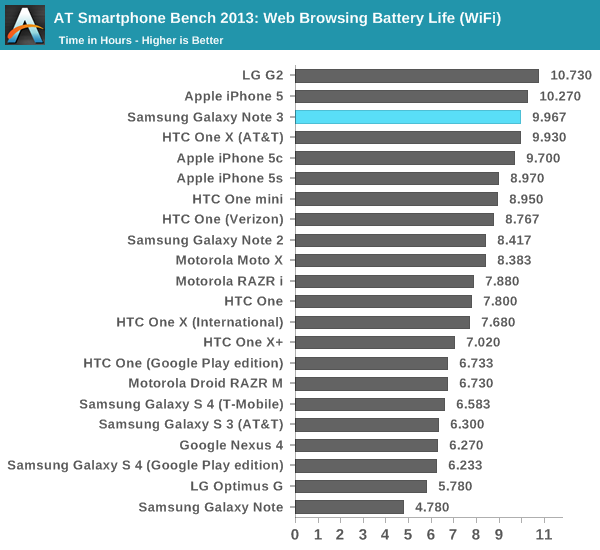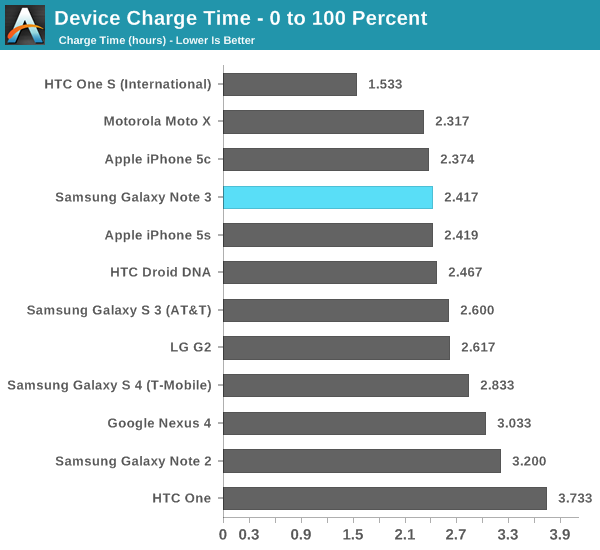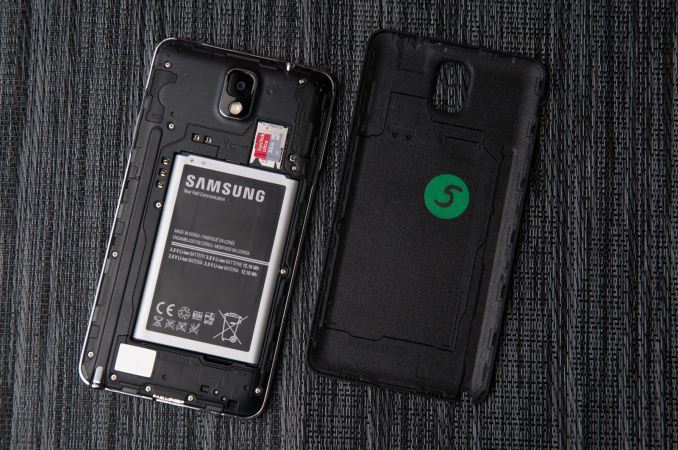Samsung Galaxy Note 3 Review
by Brian Klug on October 1, 2013 9:00 AM EST- Posted in
- Smartphones
- Samsung
- Mobile
- Android 4.3
- galaxy note 3
Battery Life
Battery life remains probably the single largest differentiator for devices lately, and of huge concern to enthusiasts and normal shoppers alike. We’ve already caught a glimpse of how well 8974 fares from a power perspective inside the LG G2, a device that posted some seriously impressive battery numbers. The Note 3 we’re looking at is also 8974 based since it’s a T-Mobile model, and thus we expect the same kind of battery life.
With this generation of Note, battery gets even larger. The Note started with a then quite large 9.25 watt hour battery, then Note 2 moved to 11.78 watt hours, and Note 3 now moves to a very large 12.16 watt hour battery with of course the newest 3.8V chemistry and all that comes along with it. Display size goes up, but those power gains are offset in other places.
After we talked about the panel self refresh features in the G2 a few people reached out and let me know that this feature has been shipping for a while in some phones, and it’s easy to check for. If we look under the display subsystem we can see that the same MIPI_CMD_PANEL type 9 is used, which refers to this type of interface.
Qualcomm HWC state: MDPVersion=500 DisplayPanel=9
define MIPI_CMD_PANEL ‘9’
Our battery life tests are unchanged and consist of a set of popular webpages that are loaded on a schedule with the display set to exactly 200 nits and repeated until the battery runs out and the device dies on both WiFi and cellular data connections. In this case that means T-Mobile LTE which is 10 MHz FDD in my market, I haven’t had a chance to run the Note 3 on HSPA+ yet, or complete the call test (which is starting to get ridiculous, and probably breaks 24 hours in the case of the Note 3).

On LTE the Note 3 does very well, coming just shy of the pack of iPhones, at just over 8 hours. Interestingly enough it’s just north of the G2s as well, which do have a smaller battery but also smaller display. The Note 3 also is the first device to ship with Qualcomm’s QFE1100 envelope tracker solution from the RF360 front end portfolio, which lowers power consumption by up to 20 percent and heat dissipation by up to 30 percent by allowing the power amplifiers to follow the desired output waveform. There’s more on that later in the cellular section.

On WiFi the Note 3 does better by 22 percent, but not the kind of huge jump I’m used to seeing between cellular and WiFi testing. This tells me the Note 3 battery life is really gated by the display, which is almost always the largest consumer of power in a device. That said the Note 3 does very well all things considered, especially in comparison to the APQ8064 (Fusion 3) phones which came before it, like SGS4. New silicon and new process inside MSM8974 definitely helps move battery life forward here with the race to sleep game.
Charging is an interesting story on the Note 3, but primarily because of what doesn’t change. The Note 3 continues to use Samsung’s tablet charging specification and charger, which has 2 amps of maximum output. The Note 3 draws 2 amps over a considerable amount of the charging curve, like other Samsung devices (in the linear part of the charge curve). USB 3.0 doesn’t change things up here quite yet with the new supported charge voltages that are coming eventually with the power delivery specification.

The Note 3 does charge faster overall compared to the SGS4 however thanks in part to the new PMIC (PM8941) which is part of the overall 8974 platform story.











302 Comments
View All Comments
cdomigan - Tuesday, October 1, 2013 - link
Extremely disappointed in AnandTech for their passive stance on benchmark cheating. Please live up to the high expectations you have set for tech journalism and call this out for what it is!Wade_Jensen - Tuesday, October 1, 2013 - link
I would've liked a bit more depth on subjective UX in terms of responsiveness and lag/stuttering. I'm sorry, but I'm starting to think that Touchwiz is just so inefficient and poorly coded that galaxy devices lag no matter how much ram and compute you throw at them.After all S600 was seen as crazy fast at the start of this year but at the end of the day the GS4 still feels slow and heavy for basic operations compared to any other ROM (except motoblur haha).
tanyet - Tuesday, October 1, 2013 - link
I agree with this wholeheartedly. Touch responsiveness and a lag free experience is what I want most in mobile devices. I can say that I haven't noticed any lag or "micro stutters" with my Note 3 and I'm really obsessed with these things. It's still not as smooth as iOS but I feel that's more to do with Android than Samsung. It took me awhile to get used to not having the bounce back effect and it also took awhile to get used to the speed of scrolling (or the abruptness of the scroll stopping) I chalk this up to patent issues. Mine definitely doesn't display the choppiness I've seen with some friends S4's. Who know though. It's early days.I would really love the TouchMarks benchmark to be added to the list of reviewer tools because I feel that it is a much better gauge of user experience than some others.
Dentons - Tuesday, October 1, 2013 - link
Come on Brian. We know you don't care about two of Samsung phone's biggest selling points, user replaceable batteries and MicroSd expansion, but not giving those real, actual features any appreciation or credit at all? That's a bit much.Unlike Brian, some of us really, really, really care that Samsung allows us to carry extra batteries and store our ever growing media libraries on MIcroSD. We know you don't care. You dismiss those features in nearly every Anandtech Podcast, but should your personal use habits so prominently factor into a review this comprehensive?
Apple doesn't have these features.
Google Nexus doesn't have these features.
HTC don't have these features.
It's a major differentiator. For many of us, it's a big deal, perhaps one of the primary reasons many will buy this phone over its competitors.
ScorpionRaY - Tuesday, October 1, 2013 - link
Agree!nerd1 - Wednesday, October 2, 2013 - link
Totally agree. Nowadays micro SD memories are dirt cheap and apple is still charging $100 for extra 16GB...Davidjan - Thursday, October 3, 2013 - link
Agree with you. Meanwhile we can use this Meenova MicroSD reader to add storage: http://goo.gl/U6IyYSpunjji - Tuesday, October 8, 2013 - link
Entirely agreed. I'd have happily bought a Nexus 4 for a lot less money were it not utterly impossible to store my (modest!) media collection and photos downloaded from my camera on there.Similarly I refuse to pay Apple ~£160 extra just to get slightly less capacity with their flagship phone than I got for my Note 2 by paying £40 for a 64GB MicroSD card. Were it not for this option I would have to submit to the blatant scam that is NAND upgrade pricing.
tuxRoller - Tuesday, October 1, 2013 - link
Whoa, what's going on with the G2 in the 4G tests? It was far and away the best at 3G and I thought the current AT reasoning was that 4G only improved the browsing time over 3G by racing to idle? Is the Qualcomm 4G baseband that bad?ithinkux - Tuesday, October 1, 2013 - link
To me, the benchmarks presented above prove, beyond any doubt, that Apple did the right thing switching to 64-bit architecture.